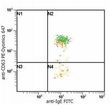Mouse IgG (Fc specific) goat polyclonal antibody, FITC
| Applications | This product is designed for Immunofluorescence microscopy, Fluorescence based plate assays (FLISA) and Fluorescent Western blotting. This product is also suitable for multiplex analysis, including multicolor imaging, utilizing various commercial platforms. FLISA: 1/10,000-1/50,000. Western blot: 1/1,000-1/5,000. Immunofluorescence: 1/1,000-1/5,000. |
| Reactivities | Mouse |
| Conjugation | FITC |






























































































































































































































































 Germany
Germany
 Japan
Japan
 United Kingdom
United Kingdom
 China
China




